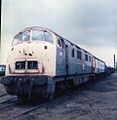British Rail Class 42 facts for kids
Quick facts for kids British Rail Class 42 “Warship” |
|
 |
|
| British Rail Class 42 No. D832 | |
| Power type | Diesel-hydraulic |
|---|---|
| Builder | British Railways’ Swindon Works |
| Build date | 1958–1961 |
| Total production | 38 |
| Configuration | B-B |
| UIC classification | B'B' |
| Gauge | 4 ft 8 1⁄2 in (1,435 mm) |
| Wheel diameter | 3 ft 3+1⁄2 in (1.003 m) |
| Minimum curve | 4.5 chains (91 m) |
| Wheelbase | 48 ft 3 in (14.71 m) |
| Length | 60 ft 0 in (18.29 m) |
| Width | 8 ft 10 in (2.69 m) |
| Height | 12 ft 0+1⁄2 in (3.670 m) |
| Locomotive weight | 78 long tons (79.3 t) |
| Fuel capacity | 800 imp gal (3,600 L; 960 US gal) |
| Prime mover | Maybach MD650, 2 off |
| Transmission | Hydraulic |
| Multiple working | ◆ White Diamond |
| Top speed | 90 mph (145 km/h) |
| Power output | Engines: 1,000 hp (746 kW) × 2 |
| Tractive effort | Maximum: 48,200 lbf (214 kN) |
| Train heating | Steam generator |
| Train brakes | Vacuum |
| Career | British Railways |
| Number | D800–D832, D866–D870 |
| Axle load class | Route availability 7 (RA 6 from 1969) |
| Retired | 1968–1972 |
British Railways' (BR) Type 4 "Warship" class diesel-hydraulic locomotives were introduced in 1958. It was apparent at that time that the largest centre of expertise on diesel-hydraulic locomotives was in Germany. The Western Region of British Railways (in view of post-World War II sensibilities) negotiated a licence with German manufacturers to scale down the German Federal Railway's "V200" design to suit the smaller loading gauge of the British network, and to allow British manufacturers to construct the new design. The resultant design bears a close resemblance both cosmetically and in the engineering employed. They were divided into two batches: examples built at BR's Swindon works were numbered in the series D800 to D832 and from D866 to D870, had a maximum tractive effort of 52,400 pounds force and are the British Rail Class 42 of this article. 33 others, D833-865, were constructed by the North British Locomotive Company and became British Rail Class 43. They were allocated to Bristol Bath Road, Plymouth Laira, Newton Abbot and Old Oak Common.
Images for kids
-
D829 'Magpie' waits at Paddington in 1961







